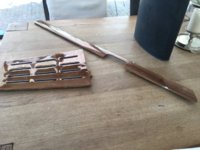it takes some time. first get the old lacquer stripped. if the lacquer is not flaking, use a chemical stripper. if it is flaking you can use a flexible putty knife ... to gently peel things off. be careful not to gouge the wood below. if the veneer is flaking then you want to remove it ... if it is not you can gently sand it and veneer over it. if it is cracking you need to peel it off ... again be careful not to gouge the wood underneath.
after you get the veneer off if you have any gouge holes, fill them with a little wood putty. then sand everything very smooth because irregularities will telegraph thru the veneer.
depending on the type of veneer, you will either have open pores or closed pores which will have different looks with the finish. the more open the pores, the less sheen you want to have. to fill the pores, you have to use a sanding sealer - perhaps 2 to 3 coats. sanding + wiping clean each time. we didn't use any stain on mine, just a clear finish.
after you get the veneer off if you have any gouge holes, fill them with a little wood putty. then sand everything very smooth because irregularities will telegraph thru the veneer.
depending on the type of veneer, you will either have open pores or closed pores which will have different looks with the finish. the more open the pores, the less sheen you want to have. to fill the pores, you have to use a sanding sealer - perhaps 2 to 3 coats. sanding + wiping clean each time. we didn't use any stain on mine, just a clear finish.


